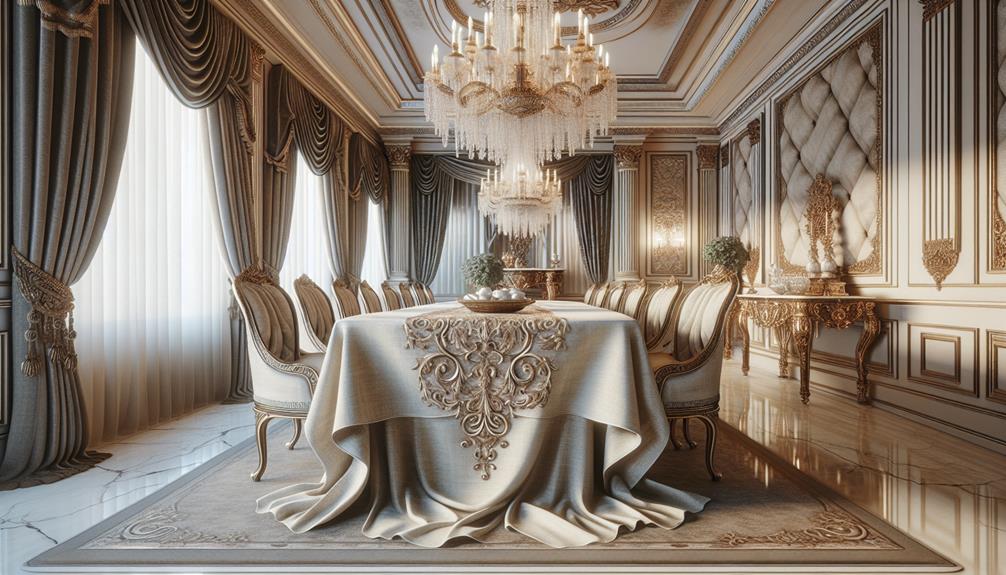Linen is definitely a luxury fabric. It has a rich history, unmatched strength, timeless elegance, and eco-friendly nature. From its cultural significance to its temperature-regulating properties, linen has been a coveted choice for centuries. It's not just a fabric; it's a symbol of sophistication and refinement, making it a versatile investment for any setting. Its durability, luxurious feel, and sustainable production methods set it apart from other fabrics. If you want to uncover more about why linen remains a top choice in the world of luxury, keep exploring its fascinating features.
Table of Contents
Key Takeaways
- Linen was initially worn by all classes before becoming a luxury fabric.
- It is associated with historical opulence and sophistication.
- Linen exudes refinement, creating a luxurious feel and appearance.
- The fabric is highly durable, often becoming treasured family heirlooms.
- Linen's sustainability, strength, and elegance make it a symbol of luxury.
The History of Linen Fabric
In the ancient world, linen fabric emerged as a versatile and widely used textile, tracing its origins back to 7000 BC. It's fascinating to think about how this fabric, made from the fibers of the flax plant, has such a rich history.
Initially, linen was a fabric that everyone could wear, from the common folk to the elite in places like Egypt and Mesopotamia. Over time, linen took on a new identity, becoming an exclusive and luxury fabric, prized for its exceptional qualities. This transformation made linen more expensive and sought after compared to other fabrics like cotton.
The crisp, cool, and elegantly wrinkled texture of linen added to its appeal, making it a symbol of sophistication and refinement. It's incredible to see how a fabric that was once so accessible became a statement of luxury and exclusivity.
Durability and Strength of Linen
Moving from its historical roots as a fabric for all classes, linen has evolved into a symbol of luxury and exclusivity, boasting exceptional durability and strength unmatched by other natural fibers. Linen stands out as the strongest natural fiber globally, known for its remarkable resilience. Its fibers are approximately twice as thick and robust as cotton, making it a top choice for long-lasting items.
The durability of linen shines through as it can withstand regular use without showing signs of wear, setting it apart from many other fabrics. Products crafted from linen often become treasured family heirlooms due to their longevity and ability to maintain quality over time. Additionally, linen is highly resistant to pilling and fading, ensuring that its appearance remains pristine even after numerous uses and washes.
The combination of strength, durability, and resilience makes linen a premium choice for those seeking both luxury and practicality in their textiles.
Luxurious Feel and Appearance of Linen
With its luxurious texture and elegant appearance, linen effortlessly elevates any setting, adding a touch of sophistication to home decor. The fabric's high-end feel and exquisite look make it a top choice for those seeking a luxurious ambiance in their living spaces. When draped over furniture or used for soft furnishings like curtains and pillows, linen exudes a sense of refinement that's unmatched. Its natural sheen and drape lend an air of elegance to any room, creating a cozy atmosphere that invites relaxation and comfort.
Not only does linen enhance the overall aesthetic of a space, but it also brings a feeling of luxury to everyday living. The high-quality appearance of linen items elevates the standard of home decor, making it a sought-after fabric for those with a taste for sophistication. Whether in the form of bedding, table linens, or upholstery, linen's luxurious feel and appearance make it a timeless choice for creating a stylish and upscale environment.
Sustainability and Eco-Friendliness of Linen
Let's chat about the eco-friendly side of linen – it's a real winner in sustainability!
From low water needs to minimal pesticides used in cultivation, linen's production is kind to the environment.
Plus, being biodegradable, linen is a top choice for those aiming to make eco-conscious fashion decisions.
Eco Benefits of Linen
Linen stands out as an environmentally-friendly choice due to its sustainable production methods and eco-friendly properties. The flax plant, from which linen is made, requires minimal water and can thrive in poor-quality soil, making it an eco-friendly option.
Additionally, the cultivation of flax for linen production involves minimal use of pesticides, herbicides, and fungicides, reducing environmental impact. The entire flax plant is utilized for various products, promoting sustainability and minimizing waste.
Moreover, linen is completely biodegradable, aligning with environmentally conscious practices. These sustainable properties and eco-friendly production processes contribute to linen's reputation as one of the most environmentally-friendly textiles available.
Sustainable Linen Production
Utilizing sustainable practices in the production of linen not only reduces environmental impact but also promotes eco-friendliness and longevity in textile choices.
The cultivation of flax for linen requires minimal water and fewer pesticides, herbicides, and fungicides compared to other crops, making it a sustainable production option.
Linen's durability and biodegradability contribute to its eco-friendly nature, ensuring a longer lifespan for the textile.
By utilizing various parts of the flax plant, waste is minimized, enhancing the sustainability of linen production.
The method of growing flax and the properties of linen position it as one of the most environmentally-friendly textiles available.
For conscious consumers seeking eco-friendly options, linen's sustainable attributes from cultivation to biodegradability make it a top choice in the market.
Linens Temperature-Regulating Properties
With its unique hollow fibers, linen effortlessly regulates body temperature throughout the year, keeping you comfortable in all seasons. Linen's temperature-regulating properties are a game-changer when it comes to clothing. Here are some key points to ponder:
- Linen's hollow fibers make it highly breathable, guaranteeing proper air circulation for temperature regulation.
- It wicks away moisture and heat, keeping you cool during hot summer days.
- In winter, linen retains heat, providing warmth and comfort.
- Its ability to adapt to your body's temperature makes it ideal for all-season wear.
- Linen ensures a cozy experience by keeping you comfortable regardless of the weather outside.
Understanding how linen interacts with your body temperature can revolutionize the way you approach dressing for different seasons. The versatility of linen as a fabric truly shines through its remarkable temperature-regulating properties.
Linen as a Versatile Investment
As we explore the versatility of investing in linen, its enduring quality and potential as a family heirloom stand out as valuable traits worth considering. Linen's natural fibers make it a durable and long-lasting choice, ensuring that your investment pays off over time.
Its ability to withstand repeated use without compromising on quality makes it a cost-effective option for home decor. The value of linen goes beyond its initial purchase; it can become a cherished family heirloom, passed down through generations. This natural fabric not only adds value to your living space but also enhances the overall aesthetic with its timeless appeal.
Opting for linen isn't just a purchase; it's an investment in quality, style, and longevity. By choosing linen, you're not only acquiring a beautiful piece for your home but also securing a piece that can stand the test of time, making it a wise and valuable investment.
Linens Cultural and Historical Significance
Linen holds a rich cultural heritage, dating back thousands of years to ancient civilizations like Egypt and Greece. Its historical significance spans from being used in burial shrouds to functioning as currency and armor.
The enduring legacy of linen showcases its versatility and timeless appeal throughout different eras and societies.
Cultural Impact of Linen
Culturally significant for over 5,000 years, linen has woven its way into the fabric of ancient societies, symbolizing wealth, status, and timeless elegance.
- Linen's use dates back to ancient Egypt, Greece, and Europe, showcasing its enduring appeal.
- In ancient times, linen served multiple purposes, from clothing to currency.
- The fabric became a symbol of wealth and status in the 17th century.
- Linen's cultural impact highlights its luxurious reputation.
- The historical importance of linen emphasizes its association with sophistication and prestige.
Historical Relevance of Linen
With a legacy spanning over 5,000 years, the historical significance of linen weaves tales of opulence and endurance across ancient civilizations. Derived from flax fibers, linen clothing has been cherished for its quality fabric and natural properties.
From ancient Egypt's burial shrouds to ancient Greek armor and European wealth symbols in the Middle Ages, linen has passed down its prestige from generation to generation. In the 17th century, linen adorned the wealthy elite in formal wear, solidifying its status as a luxury fabric.
Resurging in the 20th century, linen continues to be a favored choice for clothing and home décor, appreciated for its timeless appeal and luxurious characteristics.
Frequently Asked Questions
Why Is Linen Considered Luxury?
Linen is considered luxury due to its labor-intensive production, resulting in a fabric that is durable, softens beautifully, and offers exceptional properties like breathability and hypoallergenic features. Its eco-friendly nature adds to its allure.
Does Linen Look Expensive?
Absolutely, linen looks expensive. Its natural texture and rich colors elevate any outfit or home decor. The way it drapes and the subtle sheen it gives off are unmistakably luxurious, making it a top choice for those seeking elegance.
Is Linen a Rich Fabric?
Linen, with its rich history and luxurious qualities, stands out as a premium fabric choice. Its durability, breathability, and timeless elegance make it a sought-after material for those who appreciate quality and sophistication.
What Fabric Is Considered Luxury?
Luxury fabrics like silk, cashmere, and linen are prized for their quality, exclusivity, and fine craftsmanship. They stand out for their unique characteristics, natural origins, and meticulous production processes, making them highly sought after in various industries.
- Does Linen Keep You Cool at Night? - April 9, 2024
- Is Linen Cool for Sleeping? - April 9, 2024
- Is Linen Sun Proof? - April 9, 2024





